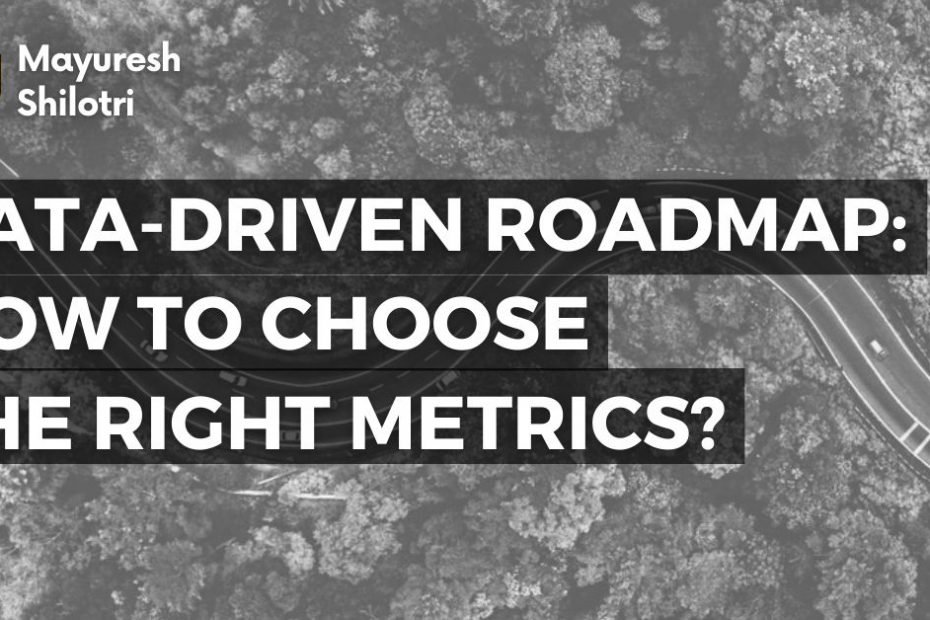It is challenging to get down to a choice based entirely on gut feeling. This is ineffective in the long term as it will deprive the organisation of flaunting its full potential. Intuition and vision take a backseat and can’t create the magic compared to data-driven insights.
The development of a data-driven roadmap requires a lot of effort and goes beyond just laying out the format for vision. Creating a practical data-driven roadmap requires real-world data, evidence, and an approach to work with the data.
- Words:1009 (Skim friendly)
- Type: Post
- Video:0
- Slides: 1
- Topic: Data-Driven Roadmap: How To Choose The Right Metrics?
- TIME: 16 Minute
Ideas for Choosing the Right Metrics To Build a Data-Driven Roadmap
It requires more than just the intuition and vision of the product manager to construct and nurture a product roadmap. Although these are crucial ingredients, factors like evidence, factual data, etc., contribute immensely.
Therefore, to understand, identify, and track accurate metrics that will strategise the product roadmap, below are some ideas.
1. Customer-oriented Metrics
Data is generated every second by prospects or the customer base. This data can be further used to understand the areas that need effort. Moreover, these data also give insight into things that require change. The metrics that these can include are:
- The quality details. These metrics will include all the bugs that users have come across.
- Adaptability is another major metric that will help to understand product usage compatibilities.
- Churn rate or customer retention data
- The number of users who work with specific actions or responses to establish marketing campaigns.
2. Prioritise the metrics
Think of tracking data with services like Google Analytics. The service is excellent and allows users to track all sorts of data, which is great.
However, using data that isn’t useful and brings no information can make the process worse. Since you already have all the data you need, try analysing the most significant metrics for your product. The data you already own is valuable and has the insights that make your product successful. All you have to do is intercept and decode them so that it benefits you.
The number of metrics is different for every organisation and strongly differs. However, paying attention to the five primary metrics over time can do wonders. These metrics must be discussed with the stakeholders and monitored time and again.
3. Not All Data Is Valuable
Not all data that you find and see is going to be helpful. Some data are no less than distractions and will help with absolutely nothing.
Thus, it is crucial to stay away from such metrics that will misguide you in the form of vanity metrics. Vanity metrics refer to the stats that look great from the outside but have no relevance or meaning—staying away from such metrics will not create a magnified approach. For best, if they are avoided.
Finding the Data-Driven Roadmap Metrics
The metrics validation will yield results only when a product exists in the market. None of the metrics will benefit you if the product is out of the picture. From creating a strategy to building the product, nothing will work out.
Here are the valuable sources that will help to provide relevant strategies.
1. Industry Analysts
Many researchers carry relevant information about the various metrics to help build a great product. Industry analysts spend a lot of time learning from competitors and studying the outside market.
Once they are done with the analysing part, they write detailed theories about the relevant products they are enjoying to work most with.
2. Industry Experts
Experts that have been all along in the industry all know the in and out of how the market is behaving. Moreover, they also understand the upcoming trends in the industry that state trends in the industry.
3. Your Colleague Competitors
Every product has its competitor ready to place bets in the market. Unless there is a scope for bringing a breakthrough in the market through the product you are creating, there are high chances that it already exists.
This also means that your competitors must have done enough research on the product. Additionally, they must have drawn the product and customer metrics. Furthermore, these metrics can focus on other product development areas that will bring more enhancements and metrics to attend to.
Steps to Data-Driven Roadmap
It is best to always start with building the product strategy. Once your strategy is laid out, it can be used to develop the roadmap. Here are a few steps to follow
- Finalise the strategic goals of the product. These goals can always be adjusted based on the metrics you will accumulate for the product.
- The next major step is to create a list of data points, including customer metrics, data metrics, and product usage statistics. More metrics can be added depending on how you plan your strategy.
- Regardless of your product’s presence in the market, you might want to research those metrics that are important. To get more into these metrics, check on the media, analysts, and other factors to focus on.
- The next step is to analyse the metrics to capture the ones that add real insights into the product. Once the metrics are narrowed down, it becomes easier to track the insights accurately.
- Remember step 1, where you identified and finalised the strategic goals? Tie these metrics with the strategic goals. Furthermore, if this causes you to shake your energy, go ahead and do that.
- Your strategy can now be incorporated with the data points and further shared with the executive stakeholders. Let them know you have the facts of the strategic decisions you plan to implement.
Conclusion
When you have a data-driven roadmap, it will not only boost your product but will also accelerate the growth of the product across companies. When there are multiple product roadmaps, it creates product experiences that people love to live by. This is the importance of choosing the right metrics and building a data-driven roadmap.
Photo by Deva Darshan
Join to get sneak peek into what's happening
I write about books, experiences, product, UX, EdTech, early stage growth, validation – mostly tech. Subscribe if these topics interest you. Once every 15 days emailer. I promise – No spam. (I am known for it otherwise) 😉




